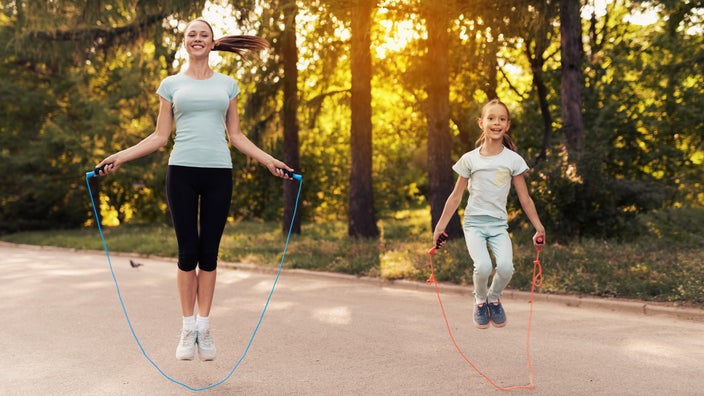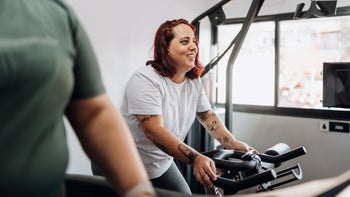
7 Surprising Health Benefits of Jumping Rope
Key takeaways:
Jumping rope is a great form of cardio for improving heart health.
It's particularly effective for lower-body power training and injury prevention.
You can practice jumping rope alongside other forms of exercise and adjust your technique based on your fitness level.
Table of contents

Whether you picture Rocky skipping rope to prepare for his next fight or children playing Double Dutch, there's no denying that jumping rope has mass appeal. But it isn't just for elite athletes or kids. The versatile and effective form of exercise offers tons of health benefits for many people.
7 benefits of jumping rope
Jumping rope is a cardiovascular or aerobic exercise that gets your heart pumping. The childhood favorite doubles as plyometric training. Plyometrics are explosive movements that combine power and speed. With plyometric exercises, you challenge your muscles to exert as much force as possible in quick intervals.
Athletes often use plyometrics to train. But beginners can try moves such as jumping rope to get started with plyometrics. And numerous jump rope benefits make the exercise a worthy addition to your workouts.
Search and compare options
1. Jumping rope provides a full-body workout
You might feel the burn in your calf muscles when you jump rope. But your calves and feet aren't the only body parts at work. Jumping rope activates multiple muscle groups. As you swing the rope around and jump, you also engage your:
Thighs (hamstrings and quadriceps)
Hips (glutes)
Abdominals
Arms (biceps and triceps)
Shoulders
Hands and wrists
With all these muscles at play, jumping rope makes for an effective total-body movement.
2. Jumping rope builds muscle power and strength
If lifting weights isn't your thing, jumping rope is one alternative to strengthen your muscles. Research shows that plyometric (or jump-training) activities increase muscle power and endurance. Those gains can help you exert more force for longer periods.
One study found that weighted jump ropes may be even more effective for building strength. The teen volleyball players who participated in the study had more lower-body strength and coordination after 12 weeks. Stronger lower-body muscles can make it easier to perform functional movements such as walking or climbing stairs.
3. Jumping rope boosts your athletic performance
If you want to boost your athletic performance, consider jumping rope regularly. In a small study, beginner endurance runners practiced jumping rope before training. Within 10 weeks, they improved their speed and jumping ability. The runners also noticed less stiffness in their feet, which might reduce the risk of injury.
Read more like this
Explore these related articles, suggested for readers like you.
4. Jumping rope increases bone density
Consider jumping rope if osteoporosis runs in your family. When you have osteoporosis, your bone density decreases over time, increasing your risk of fractures. Fortunately, weight-bearing activities such as jumping rope can strengthen your bones.
In a small-scale study, jump training improved hip bone mineral density in premenopausal women. Another study examined jump rope training and whole-body vibration in female synchronized swimmers. During whole-body vibration, you typically lie, sit, or stand on a vibrating platform for a designated time period. Synchronized swimmers may have a higher risk of osteoporosis later in life. After 22 weeks, the swimmers in the study had increased bone density in their lower backs, hips, and femur bones.
But the recommendations for exercising with osteoporosis may vary based on the severity of your condition. So check with your primary care doctor about the best exercises for osteoporosis.
5. Jumping rope improves your heart health
Jumping rope isn't just good for your muscles and bones. It strengthens your heart and lungs, too. The compound exercise raises your heart rate quickly by working multiple muscles. And jumping rope may be more efficient than other forms of cardio.
For example, a 2017 study compared indoor cycling with dance-based jump rope exercise in people with larger bodies. The people who did jump rope exercises had lower body mass indices and better vital capacity. Your vital capacity is the amount of air you can exhale after taking a deep breath. Strong vital capacity contributes to your cardiorespiratory fitness. And better cardiorespiratory fitness means you can exercise longer with less effort.
6. Jumping rope enhances balance and coordination
Mind-body exercises such as tai chi and yoga aren't the only way to improve your balance and coordination. Jumping rope requires coordination between your feet, eyes, and hands. You need balance, rhythm, and agility as you complete repetitive movements. So it's a good way to sharpen those skills.
In a 2021 study, young male volleyball players added plyometric jumping exercises to their training. After 8 weeks, they had better lower-leg stability, which may lower the chance of knee and ankle injuries. Another study found that, when combined with soccer training, jumping rope may improve children's balance and motor coordination.
7. Jumping rope is fun and adaptable
Jumping rope is also fun and adaptable. It might boost your mood by helping you feel like a kid again. And there are plenty of ways to incorporate and adjust the activity based on your fitness level.
If you're a beginner, you can start with the standard method. People at the intermediate or advanced level can increase the intensity by using a weighted jump rope, alternating between single-leg jumps, or trying double-unders. With double-unders, you swing the rope under your feet two times per jump.
Plus, you can do the versatile exercise almost anywhere. And you're never too old for it. Jumping rope can be safe and beneficial for people of all ages, including older adults.
How to jump rope
You're probably familiar with the basics of jumping rope. But a refresher on proper form can help you maximize the benefits and reduce your risk of injury. Here's how to jump rope:
Step 1: Stand with your shoulders down, back straight, and eyes ahead.
Step 2: Hold a jump rope handle in each hand, and start with the rope behind your feet.
Step 3: Squeeze your abdominals to engage your core.
Step 4: Move your wrists in a small circular motion to swing the rope overhead.
Step 5: Bend your knees slightly, and jump as the rope moves toward your feet. Try to land softly, and stay on the balls of your feet.
Step 6: Repeat for 5-10 minutes. Beginners can start with shorter jump rope sessions and gradually work up to 10 minutes or more at a time.
How long do you need to jump rope to enjoy these benefits?
The great thing about exercise is that it's cumulative. That means you can reap the health benefits by staying active over time. And no amount of exercise is too small, as some physical activity is better than none.
So if you're short on time, you can add jumping rope to short, 10-minute workouts throughout the day. But make sure you're properly warmed up first. Jumping rope and other plyometric movements often work best toward the middle or end of a workout. For example, you can jump rope as part of a circuit training or high-intensity interval training (HIIT) workout. That way, your muscles are prepared for the powerful moves.
While there's no recommendation on how often you should jump rope, remember that consistency is essential. The CDC recommends that adults get 150 minutes of moderate aerobic activity each week. And in many of the cited studies on plyometrics, participants jumped rope two to three times per week and saw significant improvements.
The bottom line
Many people associate jumping rope with kids on the playground. But research shows that it's a great way to improve your heart health, muscle strength, and coordination. That explains why so many athletes include it in their training. You can enjoy the benefits of jumping rope by adding the versatile activity to your workouts.
Why trust our experts?



References
Albaladejo-Saura, M., et al. (2021). Effect of an injury prevention program on the lower limb stability in young volleyball players. The Journal of Sports Medicine and Physical Fitness.
Bellver, M., et al. (2021). Jumping rope and whole-body vibration program effects on bone values in Olympic artistic swimmers. Journal of Bone and Mineral Metabolism.
Centers for Disease Control and Prevention. (2022). Does osteoporosis run in your family?
Centers for Disease Control and Prevention. (2022). How much physical activity do adults need?
Cooper, R., et al. (2011). Physical activity across adulthood and physical performance in midlife: Findings from a British birth cohort. American Journal of Preventive Medicine.
Davies, G., et al. (2015). Current concepts of plyometric exercise. The International Journal of Sports Physical Therapy.
García-Pinillos, F., et al. (2020). Jump-rope training: Improved 3-km time-trial performance in endurance runners via enhanced lower-limb reactivity and foot-arch stiffness. International Journal of Sports Physiology and Performance.
Moran, J., et al. (2018). Effects of jumping exercise on muscular power in older adults: A meta-analysis. Sports Medicine (Auckland).
National Institutes of Health Osteoporosis and Related Bone Diseases National Resource Center. (2018). Exercise for your bone health.
National Institute of Arthritis and Musculoskeletal and Skin Diseases.(2023). Bone health and osteoporosis.
Ozer, D., et al. (2011). The effects of rope or weighted rope jump training on strength, coordination and proprioception in adolescent female volleyball players. The Journal of Sports Medicine and Physical Fitness.
Seo, K. (2017). The effects of dance music jump rope exercise on pulmonary function and body mass index after music jump rope exercise in overweight adults in 20's. The Journal of Physical Therapy Science.
Trecroci, A., et al. (2015). Jump rope training: Balance and motor coordination in preadolescent soccer players. Journal of Sports Science and Medicine.
Tucker, L. A., et al. (2015). Effect of two jumping programs on hip bone mineral density in premenopausal women: A randomized controlled trial. American Journal of Health Promotion.
Veena Kirthika, S., et al. (2019). The effect of skipping rope exercise on physical and cardiovascular fitness among collegiate males. Research Journal of Pharmacy and Technology.



























